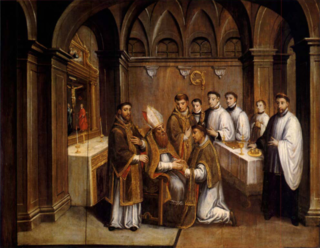
The First Council of Constantinople was a council of Christian bishops convened in Constantinople in AD 381 by the Roman Emperor Theodosius I. This second ecumenical council, an effort to attain consensus in the church through an assembly representing all of Christendom, except for the Western Church, confirmed the Nicene Creed, expanding the doctrine thereof to produce the Niceno-Constantinopolitan Creed, and dealt with sundry other matters. It met from May to July 381 in the Church of Hagia Irene and was affirmed as ecumenical in 451 at the Council of Chalcedon.

Theodosius I, also called Theodosius the Great, was a Roman emperor from 379 to 395. During his reign, he succeeded in a crucial war against the Goths, as well as in two civil wars, and was instrumental in establishing the creed of Nicaea as the orthodox doctrine for Christianity. Theodosius was the last emperor to rule the entire Roman Empire before its administration was permanently split between the West and East.
The 380s decade ran from January 1, 380, to December 31, 389.
The 390s decade ran from January 1, 390 to December 31, 399
The 440s decade ran from January 1, 440, to December 31, 449.
The 360s decade ran from January 1, 360, to December 31, 369.
The 340s decade ran from January 1, 340, to December 31, 349.
The 370s decade ran from January 1, 370, to December 31, 379.
Year 380 (CCCLXXX) was a leap year starting on Wednesday of the Julian calendar. At the time, it was known as the Year of the Consulship of Augustus and Augustus. The denomination 380 for this year has been used since the early medieval period, when the Anno Domini calendar era became the prevalent method in Europe for naming years.
Fritigern was a Thervingian Gothic chieftain whose decisive victory at Adrianople during the Gothic War (376–382) led to favourable terms for the Goths when peace was made with Gratian and Theodosius I in 382.
St. Flavian I of Antioch was a bishop or Patriarch of Antioch from 381 until his death.

Saint Meletius was a Christian bishop of Antioch from 360 until his death in 381. However, his episcopate was dominated by a schism, usually called the Meletian schism.
Maximus, also known as Maximus I or Maximus the Cynic, was the intrusive archbishop of Constantinople in 380, where he became a rival of Gregory Nazianzus.

The Theodosian dynasty was a Roman imperial family that produced five Roman emperors during Late Antiquity, reigning over the Roman Empire from 379 to 457. The dynasty's patriarch was Theodosius the Elder, whose son Theodosius the Great was made Roman emperor in 379. Theodosius's two sons both became emperors, while his daughter married Constantius III, producing a daughter that became an empress and a son also became emperor. The dynasty of Theodosius married into, and reigned concurrently with, the ruling Valentinianic dynasty, and was succeeded by the Leonid dynasty with the accession of Leo the Great.
In historiography, the Later Roman Empire traditionally spans the period from 284 to 641 in the history of the Roman Empire.

Christianity in the 4th century was dominated in its early stage by Constantine the Great and the First Council of Nicaea of 325, which was the beginning of the period of the First seven Ecumenical Councils (325–787), and in its late stage by the Edict of Thessalonica of 380, which made Nicene Christianity the state church of the Roman Empire.
The Edict of Thessalonica, issued on 27 February AD 380 by Theodosius I, made Nicene Christianity the state church of the Roman Empire. It condemned other Christian creeds such as Arianism as heresies of "foolish madmen," and authorized their punishment.
In the year before the Council of Constantinople in 381, the Trinitarian version of Christianity became the official religion of the Roman Empire when Emperor Theodosius I issued the Edict of Thessalonica in 380, which recognized the catholic orthodoxy of Nicene Christians as the Roman Empire's state religion. Historians refer to the Nicene church associated with emperors in a variety of ways: as the catholic church, the orthodox church, the imperial church, the imperial Roman church, or the Byzantine church, although some of those terms are also used for wider communions extending outside the Roman Empire. The Eastern Orthodox Church, Oriental Orthodoxy, and the Catholic Church all claim to stand in continuity from the Nicene church to which Theodosius granted recognition.

Paulinus II was a claimant to the See of Antioch from 362 to 388.

Athanaric or Atanaric was king of several branches of the Thervingian Goths for at least two decades in the 4th century. Throughout his reign, Athanaric was faced with invasions by the Roman Empire, the Huns and a civil war with Christian rebels. He is considered the first king of the Visigoths, who later settled in Iberia, where they founded the Visigothic Kingdom.







